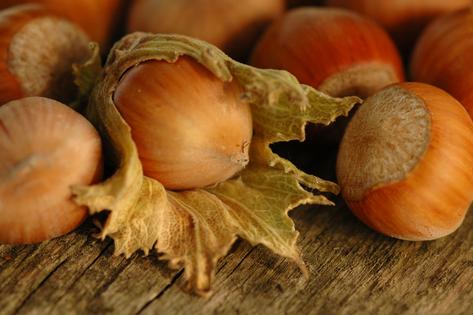Environmental Nutrition: Hail hazelnuts!
Especially popular during the holidays in sweet confections and baked goods, hazelnuts are a nutritious way to eat well during seasonal celebrations, and all year long.
The folklore
Filberts and hazelnuts (also known as cobnuts and hazels) are different names for the same tree and its small, sphere-shaped nut. The English named it hazelnut, and then French settlers came to call it filbert because the nuts would begin to ripen around August 22, St. Philibert Day. Over the centuries, hazelnuts have been revered. The ancient Chinese considered them sacred nourishment, the Greeks used them medicinally, as a cure for coughing and the cold, and the Celtics saw them as a source of wisdom, knowledge and fertility.
The facts
Hazelnuts are the nuts of hazel trees, members of the birch family. Though there are many varieties of hazelnuts, like Butler and Willamette, the common hazel (Corylus avellana) is most available commercially. Hazelnut products, such as syrups for flavored coffees, liqueurs to mix drinks, and even oils, both to enhance cooking and for skin care, are favorites.
Enjoying hazelnuts in their whole form, however, is best. A one-ounce serving, about a handful, packs 11 percent Daily Value (DV) of dietary fiber for healthy weight maintenance, 21 percent DV of skin-protecting vitamin E, and a whopping 86 percent DV of manganese, important for bone health, metabolism, and vitamin absorption. Hazelnuts are also rich in healthy, monounsaturated fatty acids, which can help prevent heart disease.
The findings
Studies have shown the benefits of regular consumption of nuts, like hazelnuts, on cholesterol levels, cardiovascular health and weight loss (Nutrients, July 2010). Daily consumption of 30 grams of hazelnuts for 12 weeks improved overall diet quality without notable changes in body weight or body fat percentage, according to research in overweight/obese individuals. Though the hazelnut eaters had higher calorie and fat intakes -- as well as vitamin E and potassium -- they did not gain weight compared to non-nut eaters (The Journal of Nutrition, 2013).
The finer points
Fresh hazelnuts come to markets in late fall and early winter. Choose shelled, raw hazelnuts from the bulk bin if possible, to ensure a rich, nutty aroma -- the best sign of freshness. Packaged shelled and unshelled nuts are available either raw or roasted. Remove skins from roasted nuts by shaking them in a closed container; they'll store in the freezer up to 24 months. Definitely divine in chocolates and sweet baked goods, hazelnuts also add crunch to salads or a Brussels sprouts or green bean sauté, and they make a wonderful pesto combined with basil or spinach and served with pasta or wholegrain crusty bread.
Green Beans with Hazelnuts and Thyme
Serves 8
2 pounds green beans, trimmed
2 tablespoons olive oil
2 tablespoons chopped fresh thyme, divided
2 teaspoons Dijon mustard
1/4 teaspoon salt
1/2 cup roasted, skinned hazelnuts, coarsely chopped
1. Bring large pot of water to boil. Add green beans, cook until just tender. Cool.
2. In a large skillet over medium high heat, add olive oil and 1 tablespoon thyme; saute for 1 minute. Stir in mustard and salt. Add beans and saute 3 to 5 minutes.
3. Stir in most of the hazelnuts, transfer to serving bowl and garnish with remaining nuts and 1 tablespoon thyme.
Nutrition information per serving: 112 calories, 9 grams (g) fat, 4 g carbohydrate 2 g protein, 2 g dietary fiber, 82 milligrams sodium.
Recipe adapted courtesy Oregon Hazelnuts
(Environmental Nutrition is the award-winning independent newsletter written by nutrition experts dedicated to providing readers up-to-date, accurate information about health and nutrition in clear, concise English. For more information, visit www.environmentalnutrition.com.)







